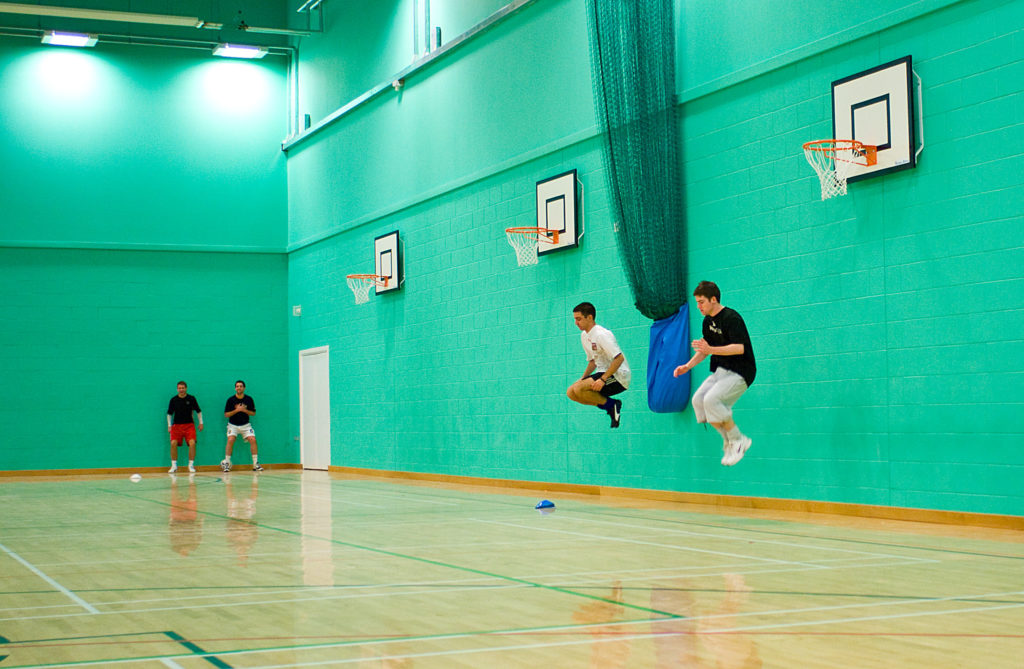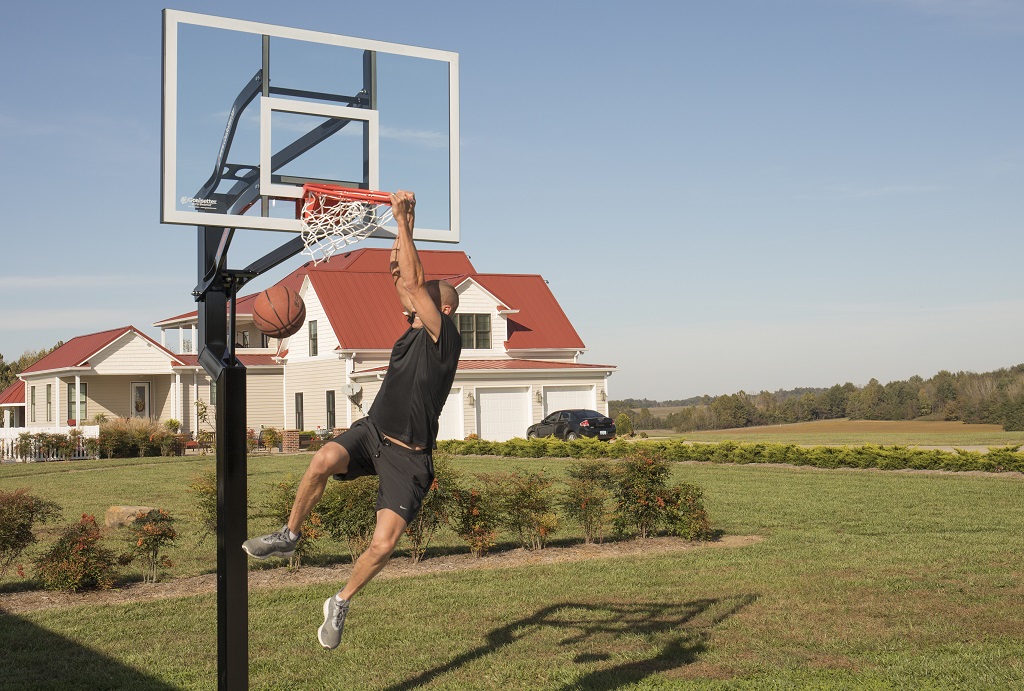Many basketball players tend to experience knee problems. Some common knee problems encountered by basketball players may include sprains, strains, Jumper’s knees, and even ligament tears.
Here, let’s discuss the common knee injuries in basketball players and their causes. Understanding these issues may help reduce the instances of these events from happening, promoting safe play without the worry of bringing harm to the knees.
We’ll also talk about why basketball players encounter these knee problems and what they do to prevent knee injuries on and off the court. Further, you’re going to learn the answer to the question, “why do basketball players put ice on their knees?”

Before answering this question, it’s essential to mention that it’s possible to treat knee pain and swelling using one of two methods: applying heat or cold. Using heat may increase blood flow to the offending area temporarily. In turn, the increase in temperature might flush out accumulated fluid, which would otherwise be a factor in muscle fatigue and an increased risk of further injury.
Conversely, the cold helps increase blood flow to the area. Again, placing an ice pack on the knee may flush out irritants and accumulated fluid. But, the body reacts to cold differently, causing continuous blood flow to attempt to warm the area.
Therefore, basketball players place ice on their knees to reduce pain and swelling that might occur while playing. Ice acts as an anesthetic, reducing pain while providing sufficient relief to allow athletes to continue with the game.
What Knee Injures in Basketball That May Need Ice?

Basketball knee injuries can range from mild issues to serious concerns. Some players can shake off the pain, put ice on the swelling, and continue the game, hoping to win the match. But, failure to have these knee concerns checked by a medical professional may result in aggravating the problem. After all, knowledge about these knee issues may help reduce the risks of these concerns from surfacing.
1. Knee Sprains and Strains
Swift left-to-right movements, constant running, and frequent jumping may look cool while viewing basketball games from the sidelines. But, sometimes different stories are portrayed for the players in the court as the athletes’ knees take beatings.
These abrupt and continuous movements may cause sprain and strains to the knees. Although both issues deliver pain to the individual, a sprain is different from a strain and vice versa.
Knee sprains generally occur when ligaments in these body parts become overstretched. Ligaments are fibrous bands consisting of connective tissue that connect bones. These tissues may tear during athletic exercises, causing trauma to the knee.
On the other hand, strains occur at tendons as opposed to ligaments. Tendons are fibrous cords made of tissue connecting muscles to bones. Overuse is one of the most common issues of knee strains, which some players may temporarily yet quickly remedy by icing their knees. However, some serious cases may occur that sends basketball athletes to the benches for the rest of the game.
Nonetheless, both issues may require ice for temporary healing. However, players need to seek immediate professional medical attention if the pain and swelling from the sprain or strain becomes unbearable.
2. Patellar Tendonitis
Also called the Jumper’s Knee, another common knee injury in basketball is patellar tendonitis. It occurs in the patellar tendon, hence the name. This body part connects the patella, or the kneecap, to the shinbone.
In a healthy body, the patellar tendon helps in various athletic movements, including jumping, kicking, and running. However, once this tendon becomes inflamed, pain and swelling start to surface.
Thankfully, most cases of patellar tendonitis are quite mild and don’t require surgery. Players may use ice or anti-inflammatory medications to help heal this injury.
3. Ligament Tears
Think of ligaments as fibrous bands that connect each bone and support everyday function. These bands may tear because of trauma or excessive use. If ligaments tear, they can’t heal without surgery. Ice may help ease the pain. But, it’s important to consult a doctor immediately if a player thinks the pain comes from a torn ligament.
Some ligaments tear if a basketball player makes an abrupt stop, jumps with incorrect for, or changes directions quickly. The damage done to ligaments because of these movements and scenarios may result in pain, swelling, and the inability to stand, walk, or run properly.
Why Do Basketball Players Have Knee Problems?

Most basketball players live by the mantra of trying to be as active and healthy as possible. This sport can be a player’s passion, and some athletes consider the activity to be their lives. But, despite the optimistic approach to the game, it doesn’t make the body impervious to all types of harm, especially to the knees.
Despite knee injuries being quite common in basketball, understanding the causes of these issues may help in preventing these concerns from happening. One excellent example of avoiding knee injuries is to do proper warmups before a game.
How Do Knee Injuries Happen in the Basketball Court?
Warming up with some slight running, jogging, or jumping may help loosen the tissues in the knees, promoting better flexibility and tension. Otherwise, exercising athletic movements without doing warmups may lead to serious knee injuries because of the stiffness.
Moving forward, some basketball players experience knee problems because of trauma. Take a look at the following scenario as an example: Player A decides to pass the ball to Player B. But, Player B is slow to react to the incoming ball and catches the object with his knee instead of his hands.
As per a post entitled The Physics of the Basketball Shot, a moving basketball in a typical game moves at about 10 miles per hour (mph). But, the ball may also move up to 18 mph, particularly during passes and throws.
Although 10 or 18 mph might not seem fast, taking the speed and weight of the ball in a relatively close distance may result in blunt force trauma. Add the repeated and rigorous knee-jerking motions made by a basketball player, and these ingredients become recipes for knee injuries.
Another example is when Houston Rockets’ center Dwight Howard has two knee problems in one year. It was 2015, and the NBA superstar didn’t attend practices or matches because of persistent trouble with his right knee, according to a report from ESPN. Then, the second injury happened when the center crashed his knee to his then-teammate Josh Smith.
Pre- and post-game stretching becomes vital in preventing these knee problems from occurring. Basketball players should use dynamic movements before a game to loosen muscles and joints. Static stretching is more feasible after the game to help the muscles and joints cool down and prevent further injury.
Accidents can still happen in the court, which may result in mild or serious knee injuries. Hence, it’s always important for basketball players to stay vigilant to reduce the risks of these problems.
What Do Basketball Players Do To Strengthen Their Knees?

According to a 2008 statistics report in the American Journal of Sports Medicine, knee injuries take up about 14.7% of the overall physiological problems happening during basketball games. Further, knee internal derangement happens in 7.4% of male players and 15.9% of female players.
Strengthening the knees may help reduce knee injuries before, during, and after basketball games. So, here are three ways basketball players do to strengthen their knees and prevent injuries.
1. Stability Exercises
Stability exercises, such as lateral lunges and bodyweight squats, can promote improved neuromuscular function, enhanced balance, and knee injury prevention, as per a 2012 study.
Basketball athletes training their stability targets muscles that act on the knees. As a bonus, these movements challenge and enhance other body parts, such as the ankle, core, and hip.
Players need to do stability exercises at low intensity while focusing on the range of motion and proper form. It’s not advisable to perform these movements hastily, which may otherwise lead to improper form and reduced chances for improvement.
2. Plyometrics
Plyometrics are exercises used to increase the speed and force of different physical movements, enhancing muscle strength and flexibility. As a bonus, these exercises can also help athletes burn calories. Proper plyometric training may also lead to an improvement in a basketball athlete’s overall physical performance within the court and daily activities.
Plyometric power exercises, like squat jumps, ball slams, and plyo pushups, put enough pressure on the knee joint for it to improve and strengthen. Over time, the muscles and tendons in the knee become more reactive and flexible, activating the body part’s full potential while doing quick movements.
3. Weight Training
Basketball players focusing on cardiovascular training may only see slight improvements in their knees. It’s still vital to incorporate lower bodyweight training in exercise programs to build knee strength and performance and reduce the risks of injuries.
Knee strength training with proper form won’t only help prevent injuries, but the right exercises may also assist in improving an athlete’s jumping ability. Some examples include straight leg raises, hamstring curls, and wall squats. Players may add resistance bands, weights, and other training equipment to these exercises to increase the load and improve progression.
Final Words - Basketball Knees Problems That May Require Ice
By now, you should know the three common knee injuries in basketball. You should also have an idea on how to prevent these injuries on and off basketball courts.
Remember, players can use certain treatment options, like heat and ice, to relieve pain from these injuries. But, it’s always a wise decision to seek the help of a medical professional to know the precise solutions to specific knee problems.
Don’t forget that certain ways exist to help strengthen the knees. Proper training may improve overall knee strength and reduce the risks of injuries.
If you have any ideas on how to improve the knees for basketball, feel free to share your thoughts in the comments below!






